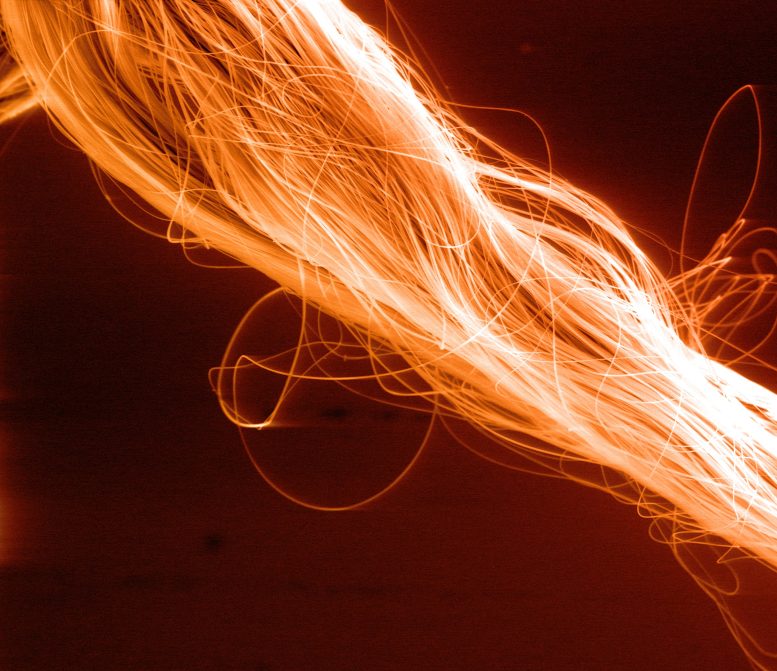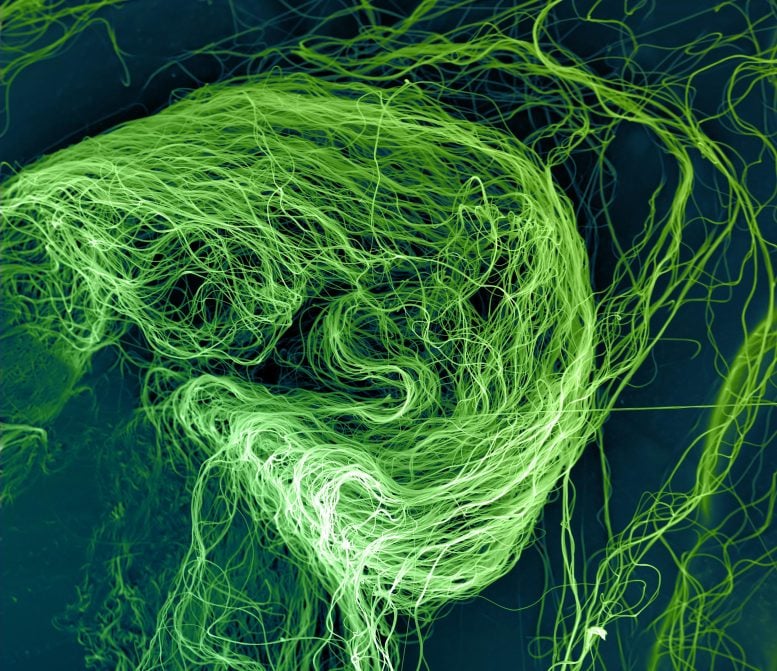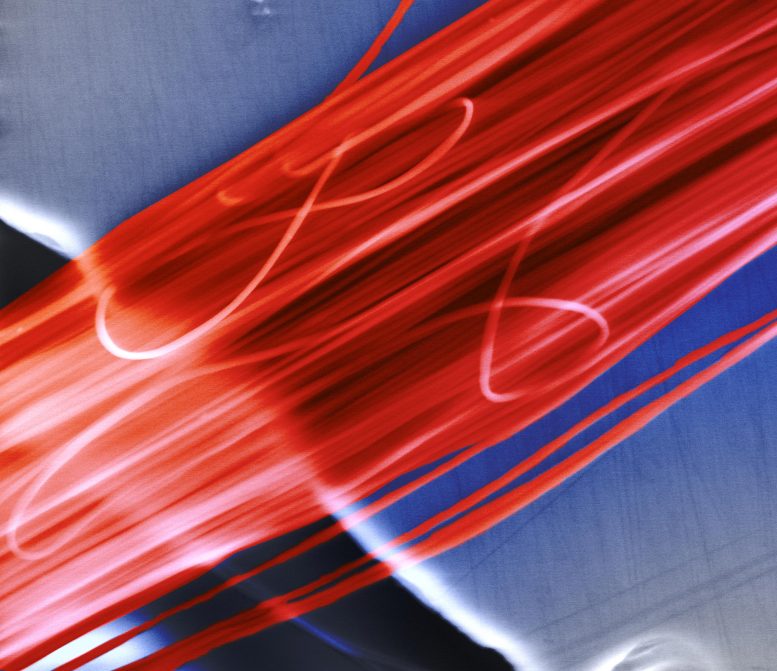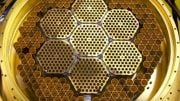
High-resolution scanning electron microscopy shows a portion of a large bundle of ultra-strong and tough continuous nanofibers developed by UNL researchers. Credit: Joel Brehm, Dimitry Papkov, Yuris Dzenis
Using a technique called electrospinning, researchers at the University of Nebraska-Lincoln have developed an exceptionally thin polyacrylonitrile nanofiber that is both strong and tough.
University of Nebraska-Lincoln materials engineers have developed a structural nanofiber that is both strong and tough, a discovery that could transform everything from airplanes and bridges to body armor and bicycles. Their findings are featured on the cover of this week’s April issue of the American Chemical Society’s journal, ACS Nano.
“Whatever is made of composites can benefit from our nanofibers,” said the team’s leader, Yuris Dzenis, McBroom Professor of Mechanical and Materials Engineering and a member of the University of Nebraska–Lincoln’s Nebraska Center for Materials and Nanoscience.
“Our discovery adds a new material class to the very select current family of materials with demonstrated simultaneously high strength and toughness.”

High-resolution scanning electron microscopy image shows strong, tough continuous nanofibers fabricated and studied by the University of Nebraska-Lincoln. Credit: Joel Brehm, Yan Zou, Yuris Dzenis
In structural materials, conventional wisdom holds that strength comes at the expense of toughness. Strength refers to a material’s ability to carry a load. A material’s toughness is the amount of energy needed to break it; so the more a material dents, or deforms in some way, the less likely it is to break. A ceramic plate, for example, can carry dinner to the table, but shatters if dropped, because it lacks toughness. A rubber ball, on the other hand, is easily squished out of shape, but doesn’t break because it’s tough, not strong. Typically, strength and toughness are mutually exclusive.
Dzenis and colleagues developed an exceptionally thin polyacrylonitrile nanofiber, a type of synthetic polymer related to acrylic, using a technique called electrospinning. The process involves applying high voltage to a polymer solution until a small jet of liquid ejects, resulting in a continuous length of nanofiber.
They discovered that by making the nanofiber thinner than had been done before, it became not only stronger, as was expected, but also tougher.

This high-resolution scanning electron microscopy image shows ultra-tough and strong continuous nanofibers developed by University of Nebraska-Lincoln engineers that can be easily aligned and bundled for handing and processing into various applications. Credit: Joel Brehm, Dimitry Papkov, Yuris Dzenis
Dzenis suggested that toughness comes from the nanofibers’ low crystallinity. In other words, it has many areas that are structurally unorganized. These amorphous regions allow the molecular chains to slip around more, giving them the ability to absorb more energy.
Most advanced fibers have fewer amorphous regions, so they break relatively easily. In an airplane, which uses many composite materials, an abrupt break could cause a catastrophic crash. To compensate, engineers use more material, which makes airplanes, and other products, heavier.
“If structural materials were tougher, one could make products more lightweight and still be very safe,” Dzenis said.
Body armor, such as bulletproof vests, also requires a material that’s both strong and tough. “To stop the bullet, you need the material to be able to absorb energy before failure, and that’s what our nanofibers will do,” he said.
Dzenis’ co-authors are mechanical and materials engineering colleagues Dimitry Papkov, Yan Zou, Mohammad Nahid Andalib and Alexander Goponenko in UNL’s Department of Mechanical and Materials Engineering, and Stephen Z.D. Cheng of the University of Akron, Ohio.
This research was funded by the National Science Foundation, the Air Force Office of Scientific Research and a U.S. Army Research Office Multidisciplinary University Research Initiative grant.
Reference: “Simultaneously Strong and Tough Ultrafine Continuous Nanofibers” by Dimitry Papkov, Yan Zou, Mohammad Nahid Andalib, Alexander Goponenko, Stephen Z. D. Cheng and Yuris A. Dzenis, 6 March 2013, ACS Nano.
DOI: 10.1021/nn400028p









If this stuff makes regular clothing bullet proof it’s going to cause some political dislocation . . . on both sides!
What I want to know is, what is the strength to weight ration? Will this new material be a candidate, or a step in the right direction at least, for development of the tether material for a space elevator?
…er, make that strength to weight RATIO… doh
And what about sustainibility? Is it good even for the enviroment or just for business. I mean, at the end of its life, the material is sustainible.
I can understand that if we will be able to build aircrafts with 1/10 of the actual weight we will use less fuel anyway, but I’m interested in the sustainability of the material itself as well
cool people,,nice to see the new creations discovered